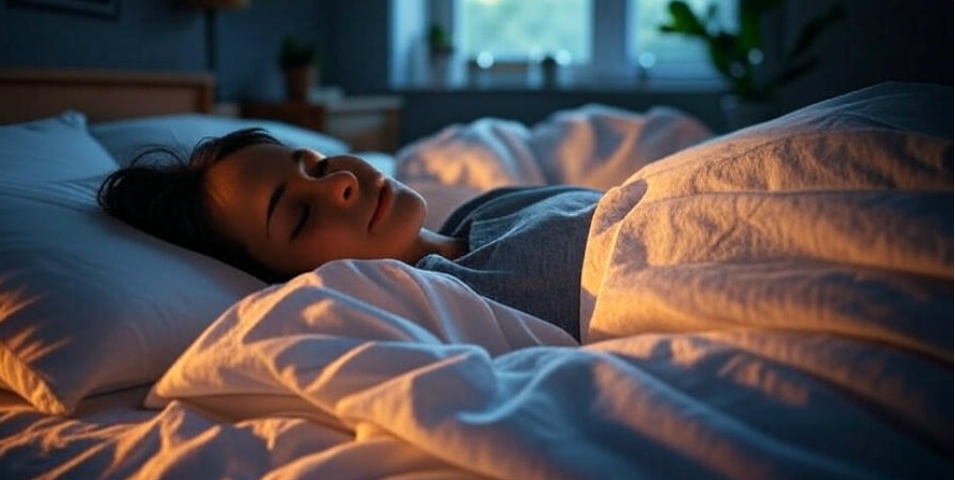Remember when counting sheep was the gold standard for falling asleep? Th
ose days feel quaint now that we’re living in an era where you can literally transport yourself to a peaceful beach or floating through space to drift off to dreamland. Virtual reality sleep therapy isn’t just science fiction anymore – it’s happening right now, and the results are honestly pretty incredible.
I stumbled across this whole concept when my neighbor Sarah mentioned she’d been using some kind of VR headset to help with her chronic insomnia. At first, I thought she was pulling my leg. Virtual reality for sleep? It sounded like the exact opposite of what you’d want before bed – more screens, more stimulation, more technology buzzing around your head. But after diving deep into the research and trying it myself, I’m convinced this might be one of the most promising sleep solutions we’ve seen in years.
What Exactly Is Immersive Sleep Therapy?
Let’s start with the basics. Immersive sleep therapy uses virtual reality technology to create deeply relaxing, three-dimensional environments designed specifically to help your brain wind down for sleep. Unlike traditional meditation apps or white noise machines, VR sleep therapy puts you directly inside calming environments where you can interact with peaceful scenes, practice guided breathing exercises, or simply exist in spaces that feel completely separate from your everyday stress.
The technology works by engaging multiple senses simultaneously. You’re not just hearing ocean waves – you’re standing on a moonlit beach, feeling the virtual breeze, watching stars twinkle overhead, and hearing the gentle crash of waves in perfect 3D audio. Your brain gets so absorbed in this peaceful environment that it naturally begins to slow down, moving from the heightened state of daily stress into the relaxed state needed for quality sleep.
What makes this different from just watching a relaxing video on your phone is the level of immersion. When you put on a VR headset, your peripheral vision is completely filled with the calming environment. There are no distractions, no notifications popping up, no real-world visual cues pulling your attention away from relaxation. It’s like having a personal meditation retreat that you can access from your bedroom.

The Science Behind Why It Actually Works
The research backing VR sleep therapy is getting pretty solid, and the mechanisms make a lot of sense when you understand how our brains process stress and relaxation. Dr. Michelle Drerup, a sleep psychologist at Cleveland Clinic, explains that immersive environments can help activate our parasympathetic nervous system – the part responsible for “rest and digest” functions – while simultaneously quieting the sympathetic nervous system that keeps us in “fight or flight” mode.
One study published in the Journal of Medical Internet Research found that participants using VR relaxation therapy showed significant improvements in sleep quality within just two weeks. The researchers measured everything from time to fall asleep to number of nighttime awakenings, and the VR group consistently outperformed those using traditional relaxation techniques.
The magic happens because VR therapy addresses multiple sleep disruptors at once. Racing thoughts get redirected to peaceful visual stimuli. Physical tension melts away as you focus on virtual breathing exercises. Anxiety about not falling asleep gets replaced by engagement with calming activities. It’s like hitting a reset button for your entire nervous system.
What’s particularly interesting is how VR therapy helps with what sleep specialists call “sleep effort” – that counterproductive cycle where you try so hard to fall asleep that the effort itself keeps you awake. When you’re immersed in feeding virtual fish in an underwater garden or watching Northern Lights dance across an Arctic sky, you’re not actively trying to sleep. You’re just existing in a peaceful space, and sleep happens naturally as a byproduct.
Real People, Real Results
The testimonials from people using VR sleep therapy read like miracle stories, but they’re backed up by measurable improvements. Take Jennifer, a marketing executive from Portland who’d struggled with insomnia for over a decade. She tried everything – prescription sleep aids, meditation apps, weighted blankets, even expensive mattresses. Nothing provided consistent relief until she started using a VR sleep program three months ago.
“The first night I used it, I was skeptical,” Jennifer told me. “I put on the headset thinking this was just another gimmick I’d waste money on. But within ten minutes of being in this virtual forest, listening to a gentle stream and watching fireflies, I felt this deep calm I hadn’t experienced in years. I actually fell asleep wearing the headset, which sounds uncomfortable but wasn’t at all.”
Jennifer now uses VR sleep therapy four to five nights per week and reports falling asleep 60% faster than before. More importantly, she’s staying asleep longer and waking up feeling genuinely rested.
Then there’s Marcus, a college student whose anxiety-driven insomnia was affecting his grades and mental health. Traditional therapy helped with the underlying anxiety, but sleep remained elusive until his therapist suggested trying VR as a complementary approach.
“The program I use has this space environment where you’re floating among stars and nebulae,” Marcus explains. “There’s soft music and this narrator with the most calming voice walking you through breathing exercises. It sounds cheesy, but when you’re actually there, surrounded by the cosmos, it puts everything in perspective. My day-to-day worries feel tiny compared to the vastness of space.”
Marcus has been using VR sleep therapy for six months and has reduced his average time to fall asleep from two hours to about twenty minutes.
Different Types of Immersive Sleep Experiences
Not all VR sleep therapy is created equal, and different approaches work better for different people. The most common categories include:
Nature Immersion Programs transport you to places like rainforests, beaches, mountain meadows, or underwater coral reefs. These work particularly well for people whose insomnia stems from urban stress or feeling disconnected from nature. The natural sounds, organic movements, and earth-toned visuals seem to tap into something primal in our brains that recognizes these environments as safe and restorative.
Space and Cosmic Experiences offer a different kind of peace – the profound calm that comes from contemplating infinity. These programs often feature slowly moving through star fields, orbiting peaceful planets, or floating in space stations with expansive views of Earth. They’re especially effective for people whose minds race with daily concerns, as the cosmic perspective helps put problems in context.
Abstract and Artistic Environments use flowing colors, geometric patterns, and synchronized music to create purely aesthetic relaxation experiences. These work well for creative types or people who find traditional nature scenes either boring or too stimulating.
Guided Meditation Spaces combine VR environments with structured meditation practices, breathing exercises, or progressive muscle relaxation. These are ideal for people who benefit from more directed relaxation activities rather than passive environmental immersion.
The Practical Side: What You Need and How Much It Costs
Getting started with VR sleep therapy is easier than you might think, though it does require some initial investment. Most dedicated sleep VR programs work with standalone headsets like the Meta Quest series, which run about $300-500. Some programs also work with smartphone-based VR viewers, which cost under $50, though the experience isn’t quite as immersive.
The software itself varies widely in price. Some basic sleep VR apps are free or cost just a few dollars, while comprehensive programs with multiple environments and features can run $20-100. Subscription-based services typically charge $10-30 per month but offer regularly updated content and personalized features.
The setup process is straightforward. Most people spend about 15-30 minutes before bed in their chosen VR environment, then remove the headset and settle into normal sleep. Some advanced programs include features that detect when you’re falling asleep and automatically fade out the experience.
One practical consideration is hygiene – you’ll want to clean the headset regularly, especially if multiple people use it. Most manufacturers provide specific cleaning instructions, and there are VR-safe cleaning wipes available.
Potential Drawbacks and Who Should Be Cautious
VR sleep therapy isn’t perfect for everyone. Some people find any technology use before bed disruptive to their natural sleep rhythms, regardless of the content. Others experience motion sickness or eye strain from VR headsets, especially during the adjustment period.
People with certain medical conditions should consult healthcare providers before trying VR sleep therapy. This includes individuals with epilepsy, severe anxiety disorders, or those taking medications that affect balance or spatial perception. Pregnant women should also check with their doctors, as some VR experiences involve movement that might cause nausea.
There’s also the question of dependency. While VR sleep therapy doesn’t create the same physiological dependence as sleep medications, some users worry about becoming psychologically reliant on the technology. Sleep specialists generally recommend using VR therapy as one tool among several, not as a permanent replacement for good sleep hygiene practices.
The Future of Sleep Technology
Looking ahead, VR sleep therapy is rapidly evolving. Developers are experimenting with biometric integration, where the VR experience adjusts in real-time based on your heart rate, breathing patterns, and other physiological indicators. Some programs are beginning to incorporate personalized AI that learns your preferences and stress patterns, creating increasingly customized relaxation experiences.
There’s also growing interest in combining VR sleep therapy with other treatments. Some sleep clinics are pairing VR sessions with traditional cognitive behavioral therapy for insomnia, creating comprehensive treatment programs that address both the psychological and environmental factors affecting sleep.
Research is expanding too. Current studies are exploring how VR sleep therapy affects different demographics, optimal usage patterns, and long-term effectiveness. Early results suggest that benefits can persist even after people stop using the technology regularly, indicating that VR therapy might help retrain sleep habits permanently.
Is Immersive Sleep Therapy Right for You?
If you’re dealing with occasional sleeplessness, chronic insomnia, or just want to improve your overall sleep quality, VR sleep therapy offers a unique approach worth considering. It’s particularly promising for people who haven’t found success with traditional methods, those whose sleep issues stem from stress or anxiety, and anyone drawn to technology-assisted wellness solutions.
The key is approaching it with realistic expectations. VR sleep therapy isn’t a magic cure that works overnight for everyone, but for many people, it provides a powerful tool for creating the mental and physical conditions needed for quality sleep. In our increasingly connected, stimulating world, sometimes the solution to better rest is counterintuitively found in more technology – just technology designed with sleep and restoration in mind.
As we continue to understand more about sleep science and virtual reality’s therapeutic potential, immersive sleep therapy represents an exciting frontier in personal wellness. It’s not about replacing good sleep habits, but about giving ourselves new tools to achieve the rest our bodies and minds desperately need.



